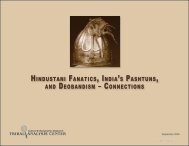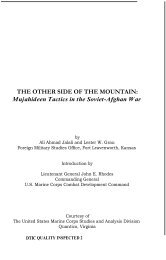the baluch and the brahui and their rebellions - Tribal Analysis Center
the baluch and the brahui and their rebellions - Tribal Analysis Center
the baluch and the brahui and their rebellions - Tribal Analysis Center
You also want an ePaper? Increase the reach of your titles
YUMPU automatically turns print PDFs into web optimized ePapers that Google loves.
The Baluch <strong>and</strong> <strong>the</strong> Brahui - <strong>and</strong> <strong>the</strong>ir RebellionsAfghanistan. Akbar Bugti’s gr<strong>and</strong>son 19 <strong>and</strong> probable heir, Brahmdakh Bugti, took <strong>the</strong> usual route into <strong>the</strong> safety across <strong>the</strong> border, but this only addsto <strong>the</strong> tension between Afghanistan <strong>and</strong> Pakistan while both <strong>the</strong> Bugti <strong>and</strong> Marri tribes took casualties from <strong>the</strong> Pakistani army attacks. This willensure a ready supply of antagonized militant tribesmen who will be available to rally to support <strong>the</strong> first charismatic leader to emerge against <strong>the</strong>Pakistan government that remained determined “more often than not are out to destroy <strong>the</strong>m by every means in <strong>the</strong>ir power,” as C. E. Bruce’s wordsbecame prophetic. He knew that <strong>the</strong> “middlemen” living in towns believed that tribes must be eliminated as social organizations if new nation statesare to survive <strong>and</strong> his prophecy is clearly playing out in Baluchistan.The dictum “more often than not are out to destroy <strong>the</strong>m by every means in <strong>the</strong>ir power” appears to have played itself out as well among <strong>the</strong>Brahui since <strong>the</strong>y seem to have vanished from <strong>the</strong> tribal <strong>and</strong> political scene. The very ethnic group that assembled a powerful confederation to control<strong>the</strong> Baluch tribes is no longer a major participant <strong>and</strong> is usually reported as being assimilated into <strong>the</strong> Baluch tribes. There was no doubt in <strong>the</strong> reportsfiled by R. G. S<strong>and</strong>eman in 1869:“…with reference to <strong>the</strong> present disturbed state of Khelat, <strong>and</strong> <strong>the</strong> effect it has on <strong>the</strong> Khan’s hill subjects, <strong>the</strong> Murrees,Boogtees, &c…. The whole of Beloochistan, from Humund (a town of Dera Ghazee Khan) to <strong>the</strong> sea, was under <strong>the</strong> sway ofNurseer Khan of Khelat, a chief noted for his justice <strong>and</strong> prowess. He kept <strong>the</strong> Murrees, Boogtees, <strong>and</strong> o<strong>the</strong>r tribes residentalong <strong>the</strong> Kafila route from Central Asia, as in good order as he did <strong>the</strong> people of <strong>the</strong> plains….” 20Ano<strong>the</strong>r report showed <strong>the</strong> authority of <strong>the</strong> Khans of Kelat:“…Still <strong>the</strong>re is <strong>the</strong> fact … that <strong>the</strong> Shum Plain belongs chiefly to <strong>the</strong> Murrees <strong>and</strong> Boogtees (nominal subjects of <strong>the</strong> Khanof Khelat….” 21But all of <strong>the</strong> tribal balance of power shifted dramatically when <strong>the</strong> Pakistanis absorbed Kalat. The last Brahui leader, Ahmad Yar Khan, declaredKalat independent in 1947 <strong>and</strong> Pakistan’s army occupied Kalat <strong>and</strong> forced <strong>the</strong> Khan to sign <strong>the</strong> accession documents. 22 Since <strong>the</strong>n, <strong>the</strong> Brahuiinfluence in Baluchistan has nearly vanished <strong>and</strong> observers of <strong>the</strong> slowly evolving insurgency in Baluchistan should remember <strong>the</strong> following:“Such a system might work well so long as <strong>the</strong>re was a strong ruler in Kalat, but once his power diminished, <strong>the</strong> naturalresult was civil war…”19. http://www.paktribune.com/news/print.php?id=158760 accessed 21 August 2009. According to <strong>the</strong> article, Pakistan intelligence agencies located Brahmdakh <strong>and</strong>dem<strong>and</strong>ed of Afghan government to h<strong>and</strong> him over to Pakistani authorities. Pakistan intelligence agencies dem<strong>and</strong>ed <strong>the</strong> Afghans h<strong>and</strong> over Brahmdakh to Pakistan as he wasinvolved in several acts of murder <strong>and</strong> terrorism, <strong>the</strong>ir usual complaint about tribal leaders leading insurgencies.20. Papers Related to <strong>the</strong> Affairs of Khelat, No. 482, dated 14 th December 1869, Enclosure 3 in No. 1, from R. G. S<strong>and</strong>eman, Officiating Deputy Commissioner, Dera Ghazee Khanto Lieutenant-Colonel S. F. Graham, Commissioner <strong>and</strong> Superintendent, Derajat Division.21. Papers Related to <strong>the</strong> Affairs of Khelat, Enclosure 1 in No.1, No. 8, dated 11 th January 1870, from Lieutentant-Colonel S. F. Graham, Commissioner <strong>and</strong> Superintendent, DerajatDivision. To T. H. Thornton, Esq., D. L. C., secretary to <strong>the</strong> Government of Punjab.22. Kukreja, Veena, Contemporary Pakistan: Political Processes, Conflicts, <strong>and</strong> Crises, pg. 131.<strong>Tribal</strong> <strong>Analysis</strong> <strong>Center</strong>, 6610-M Mooretown Road, Box 159. Williamsburg, VA, 23188
















